- Estimated $26.8T U.S. CRE investable universe
- Institutional-quality represents $11.7T (44%)
- Residential sectors dominate
- Alternative sectors account for over 30%
- Rising investment in alternative sectors embodies evolving CRE Landscape
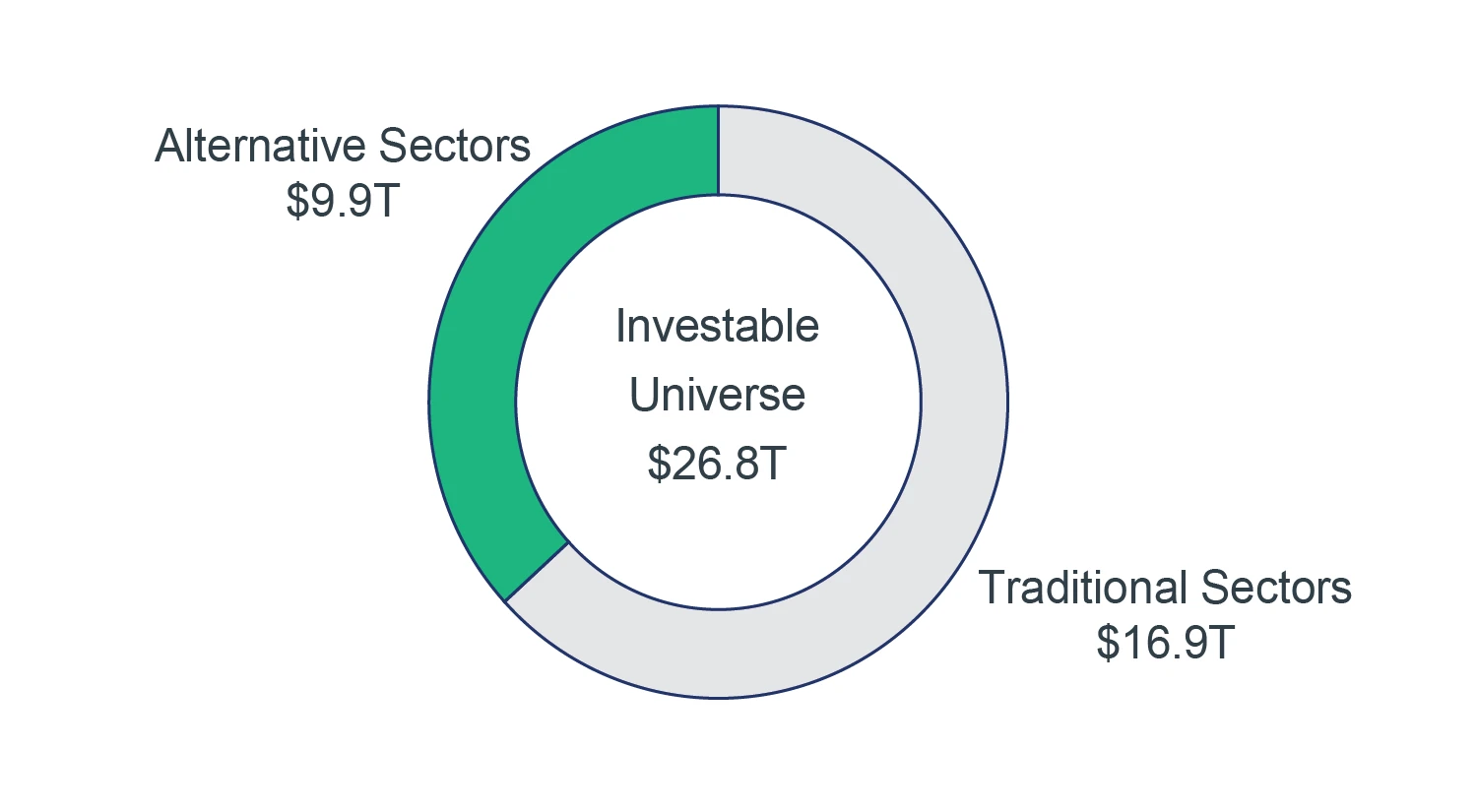
Source: Clarion Partners Investment Research, RCG; As of H1 2024.
WHY MEASURE THE INVESTABLE UNIVERSE?
The goal of this analysis is to provide investors with a benchmark for the size and scale of the U.S. commercial real estate (CRE) market, individual property sectors and the “institutional” quality portion of the market. Up to this point, published estimates on the size of the commercial real estate investable universe primarily focus on country-level global comparisons, taking a top-down approach to estimate the size of the overall commercial real estate market in each region. Existing literature does little to estimate the value of specific property types, let alone alternative property sectors. This report aims to fill this gap in the commercial real estate information landscape. Focusing exclusively on the United States, this report takes a bottom-up approach, aggregating estimates for the size of individual commercial real estate property types to arrive at a value for the overall commercial real estate market. This approach allows for segmentation between traditional and alternative property types, as well as the ability to estimate the share of “institutional” real estate by sector.
Just how big is the U.S. commercial real estate market? Although a seemingly straightforward question, estimating the size of the market is challenging for several reasons: lack of data and transparency (especially for smaller, less-liquid and historically tracked property sectors), the widely diverse nature of the range of investible property types, and inconsistent industry definitions/classifications.
This analysis attempts to answer the question through a two-step process: first, estimating the gross asset value of each property sector regardless of ownership, occupancy, tenure, size, location, and quality. After arriving at an estimate for the overall size of each sector, the second step is to apply filters based on assumptions for building class, vintage, size and/or market to further narrow the investable universe to only include institutional assets – a subsegment of the investable universe that is limited to properties that fit the typical criteria of institutional investors.
Sector sizes are estimated using the most reliable private and public data sources for commercial real estate available, while also leveraging the knowledge and insights generated by Clarion and Rosen Consulting Group (RCG)’s experience in the market. For most sectors, the approach to calculating the overall value involves estimating the physical size of the sector, be it square footage, units, rooms, or beds; and combining this with an estimated value based on recent transaction data. Less historically tracked property sectors require more assumptions to estimate market-level and still-fluid industry definitions. For property sectors where square footage or unit counts were not available, total value was estimated using information from third-party data sources or insights from market participants.
OUR ESTIMATE OF THE INVESTABLE UNIVERSE
We estimate the total size of the U.S. CRE investable universe to be $26.8 trillion.
However, from an institutional investor’s perspective, this is an overestimate, as it includes properties that fall below typical institutional standards for building size and quality. Similarly, this broad measure of the CRE universe includes a full range of geographies, including markets that are generally too small or insufficiently liquid for institutional investors. As such, we filtered our investable universe value using a meticulous series of assumptions to generate an “institutional” universe estimate. These filters vary by property sector and include building location, quality, age and size. Through this approach, the total size of the institutional universe is estimated to be $11.7 trillion. Note, that this is over ten times the size of the largest commercial real estate index, the NCREIF Property Index, (NPI).

Source: Clarion Partners Investment Research, RCG; As of H1 2024.
1) Alternatives include Office and Industrial R&D (Life Sciences), Data Centers, Age-Restricted Apartment, Student Housing, Cold Storage,
Seniors Housing, Self-Storage and Medical Office. All transactions are greater than $2.5 million. Land transactions are not included.
We segment the investable universe into two broad categories: Traditional and Alternative property types.
TRADITIONAL PROPERTY TYPES MAINTAIN A DOMINANT SHARE
"Traditional” property sectors, which include industrial, multifamily, office, retail, and hotels are valued at $16.9 trillion, accounting for 63% of the investable market. Of this total, 48%, or $8.2 trillion, is estimated to be of institutional quality. Within the $11.7 trillion institutional universe, traditional sectors then account for close to 70% of the total. With a value of $2.6 trillion, apartments are the largest traditional sector, accounting for more than one-fifth of the institutional universe.
ALTERNATIVE PROPERTY TYPES ARE A SIGNIFICANT AND RISING COMPONENT
“Alternative” sectors, which include property types that have historically not been the predominant focus of institutional investors, account for the remaining 37% ($9.9 trillion) of the investable universe and $3.6 trillion, or 31%, of the institutional universe. The alternative subsegment of the CRE universe includes the property types shown below. Many listed REITs have been long-time players in the alternative sectors, but non-REIT investment has historically been limited. However, alternatives are an increasing share of institutional-investor portfolios.
There are three identifiable groupings within the alternatives subset of the institutional market:
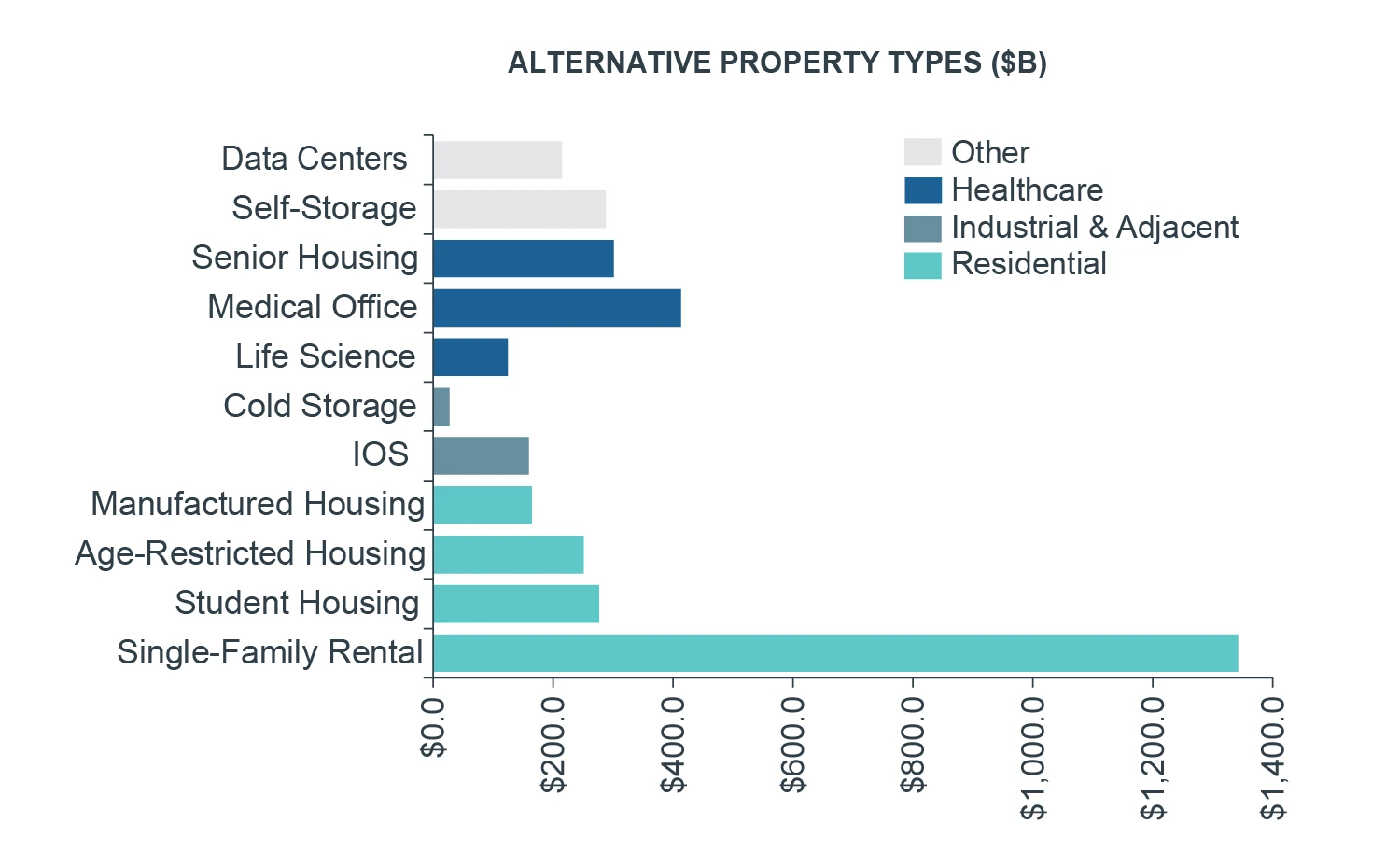
Source: Clarion Partners Investment Research, RCG; As of H1 2024.
THE RESIDENTIAL SECTOR IS THE LARGEST COMPONENT
The residential alternatives grouping (inclusive of single-family rentals, student housing, age-restricted housing, and manufactured housing) is valued at $2 trillion, or 17% of the institutional universe. Within this group, the single-family rental sector (with 3.9 million houses) has the largest estimated value ($1.3T), accounting for 11.5% of the institutional universe. The student housing sector is the next largest housing sector within the group, comprised of 2.4 million beds with a valuation of $277B, followed by age-restricted housing at $251B and manufactured housing at $165B. Combining the residential alternatives grouping with traditional apartments results in the combined valuation of $4.7 trillion, making housing in a broader sense account for the lion’s share (40%) of the institutional universe.
INDUSTRIAL AND ADJACENT SECTORS
Comprised of industrial outdoor storage (IOS) and cold storage warehousing, the industrial-adjacent group is valued at $187B, amounting to 1.6% of the institutional universe. Combining this group with the traditional industrial market results in a value of $1.5 trillion, or 13.1%, of the institutional universe.
HEALTHCARE SECTOR
The healthcare property types: life sciences, medical office, and seniors housing, have a combined estimated institutional value of $839B, equating to 7.2% of the institutional universe. With a value of $413B, medical office accounts for close to half of the value of the combined healthcare sector, followed by senior housing ($302B) and life sciences ($125B).
AN EVOLVING CRE LANDSCAPE
The CRE investment landscape is evolving quickly. Certain traditional sectors, such as office and retail, have faced structural challenges in the last decade, reducing their overall share of the investable universe by value; meanwhile, many alternative sectors have seen values increase substantially due to strong tenant and investor appetite. As a result, the share of capital flowing into the alternative sectors has increased substantially. Investments in alternative CRE sectors amounted to $14.2B in transaction volume over the past four quarters, accounting for 16% of total CRE volume, well above the share since 2014 of 13%, according to MSCI Real Capital Analytics.
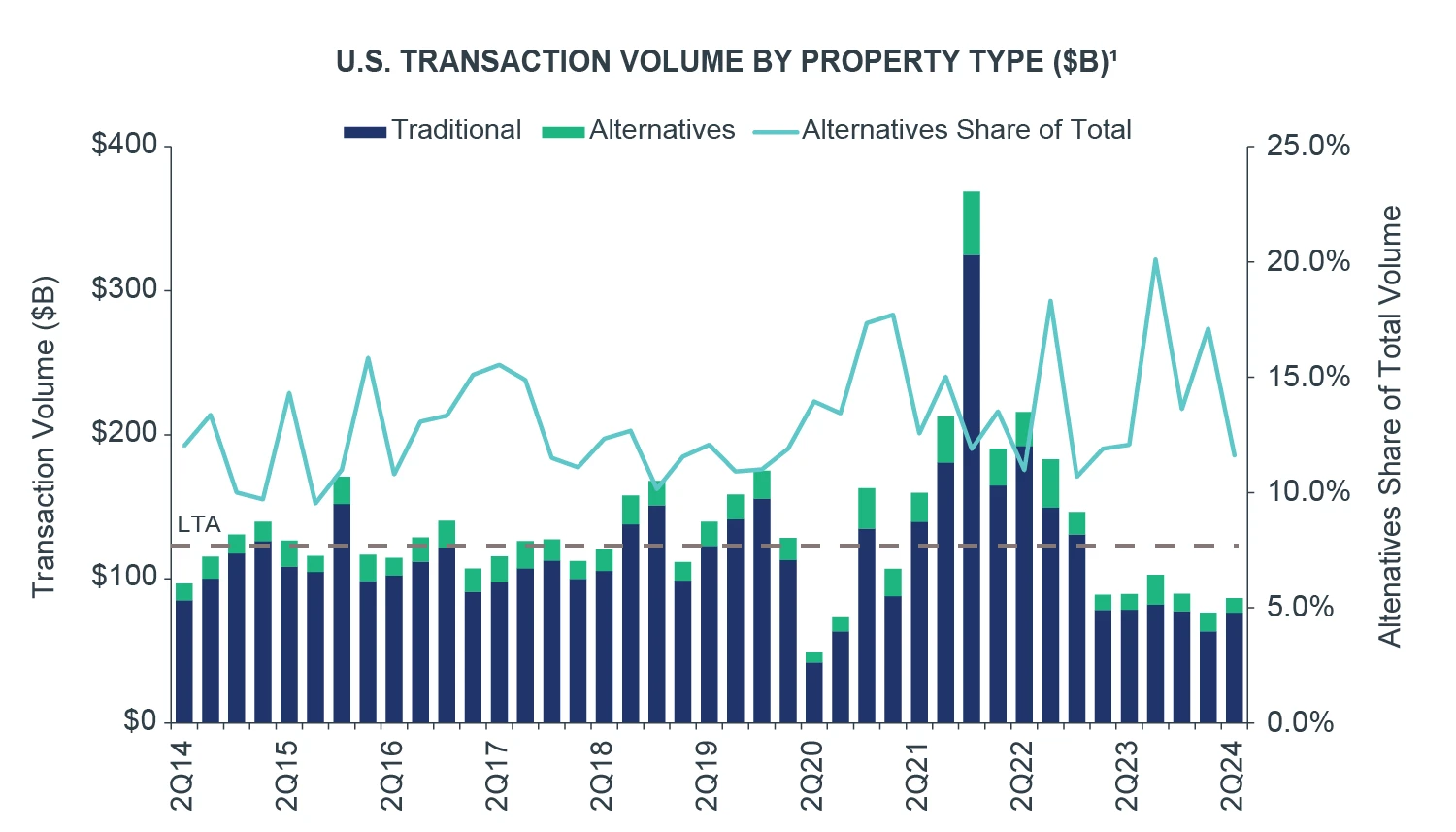
Source: Clarion Partners Investment Research, RCG; As of H1 2024. 1) Alternatives includes Office and Industrial R&D (Life Sciences), Data Centers, Age-Restricted Apartment, Student Housing, Cold Storage, Seniors Housing, Self-Storage and Medical Office. All transactions are greater than $2.5 million. Land transactions are not included.
Institutional investor interest in the alternative sectors has grown as well. The alternative sector share of the NCREIF Open-End Diversified Core Equity Index (ODCE) has increased from around 4% in 2017 to 12.9% as of 2024 Q2, led by investments in self-storage and life sciences – the largest alternative property sectors in the ODCE portfolio.
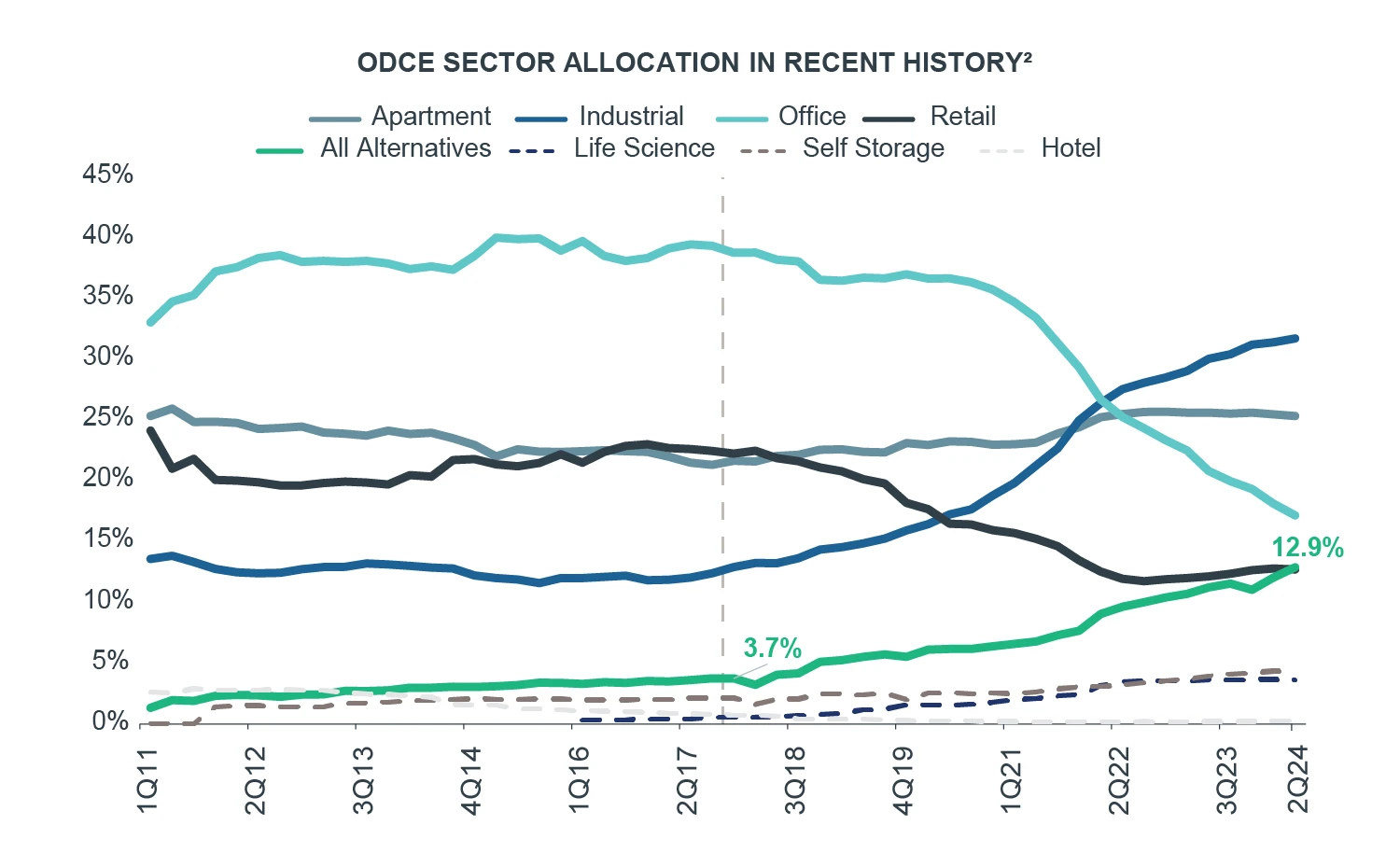
2) Alternatives include Life Sciences, Medical Office, Manufactured Housing, Single-Family Rental, Student Housing, Self-Storage, Data Center, Senior Housing and Land/Other. Past performance is not indicative of future results
The evolution of the CRE market and increased appetite for real estate investments outside of the traditional property types has brought alternative sectors to the forefront of the minds of CRE investors.
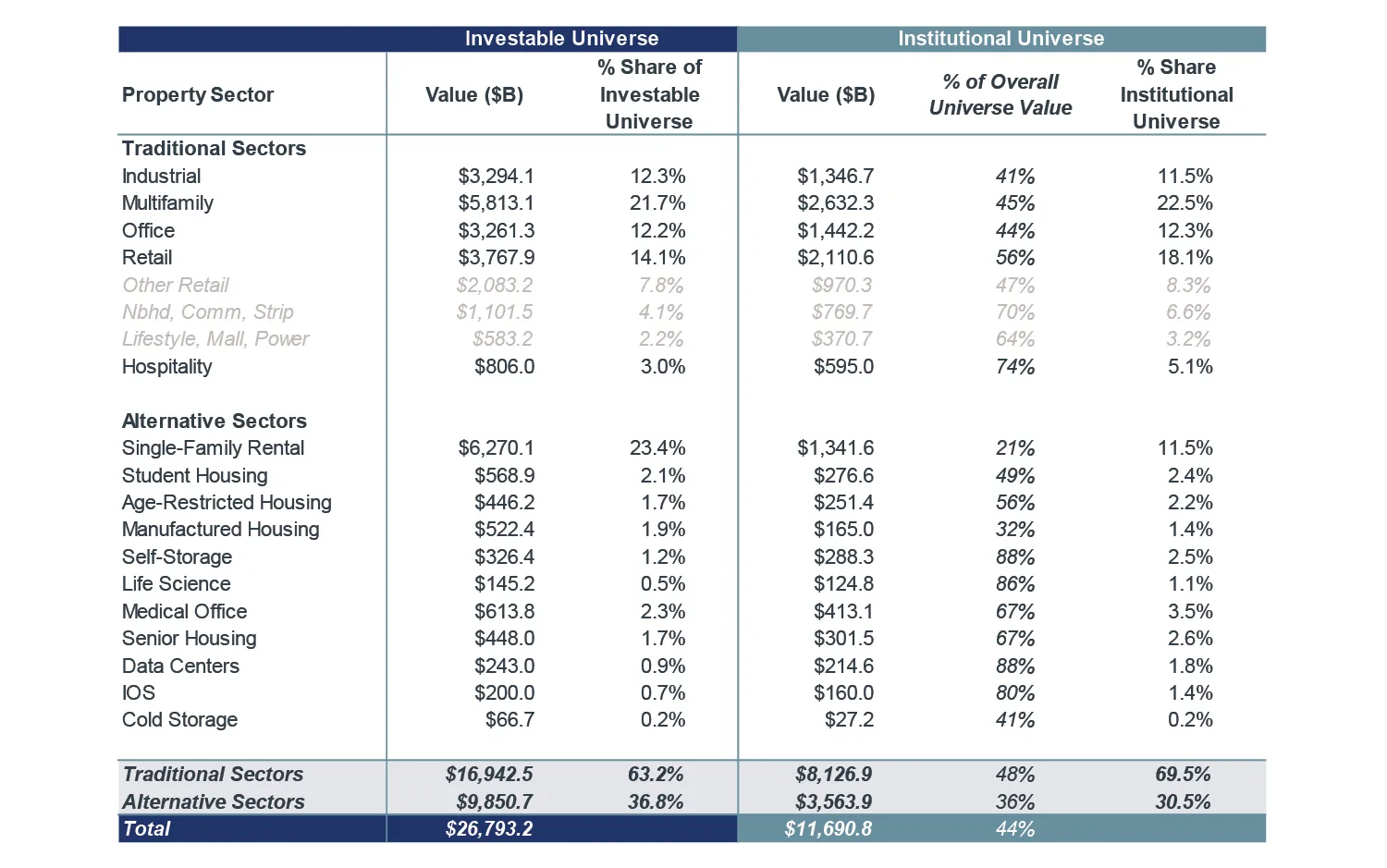
Source: Census, BLS, Moody’s Analytics, USDA, National Association of Realtors, U.S. Energy Information Administration, NICMAP, RevistaMed, Lodging Econometrics, Yardi Matrix, Greenstreet, Marcus & Millichap, CBRE-EA, CBRE, JLL, Joint Center for Housing Studies of Harvard University, MSCI Real Capital Analytics, Rosen Consulting Group, Clarion Partners Investment Research.
The Uses and Benefits of Estimating the Investable Universe